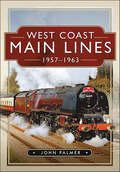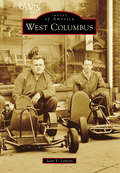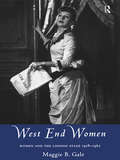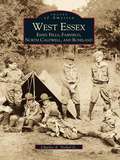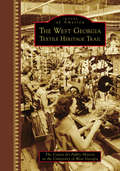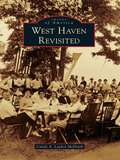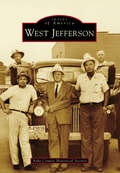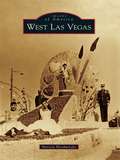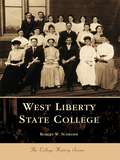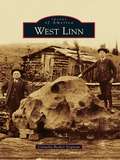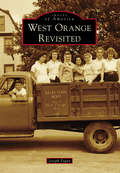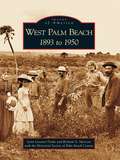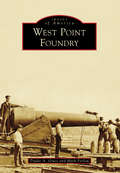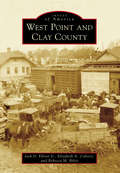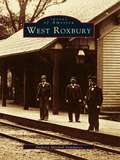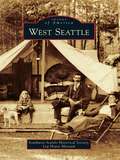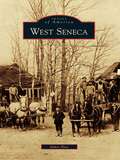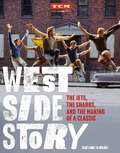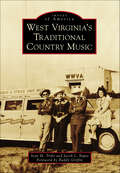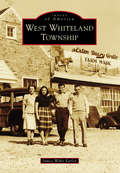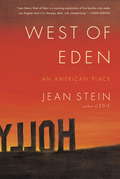- Table View
- List View
West Coast Main Lines, 1957–1963
by John PalmerThroughout its length from London to Glasgow via Crewe and Carlisle, with a loop through the West Midlands and spurs to Holyhead,Liverpool and Manchester, the West Coast Main Line has consistently provided interest for those many with more than a passing interest in trains and travel. This book outlines the history of the route,its physical characteristics and sets the scene for the various passenger and goods traffic flows that sustained it; it then details the arrangements for motive power and train working through the era of change that was 1957 to 1963. The level of interest - as evidenced daily by the presence at the lineside of hordes of young spotters and other observers - was particularly high at that time as processions of trains hauled by fine express passenger locomotives and those more suited to other traffic passed by. The book also goes 'behind the scenes' to provide insights into the daily and seasonal challenges of managing that section of a wider railway network, as directed by the varying terms of relevant legislation, and a government increasingly concerned to shape the railways for the changing needs of the public, industry and the economy. The book will be of particular interest to those who simply recall those days by the lineside, those with an interest in detailed arrangements to provide and maintain suitable motive power, those with an interest in how the railway served the needs of the nation and modellers who seek information. The book is illustrated with color and monochrome images and supported by maps.
West Columbus
by Sean V. LehositPresent-day West Columbus is a collective of neighborhoods born from the western banks of the Scioto River in what became Franklin County on April 30, 1803. The first settlement, Franklinton, was founded by Lucas Sullivant in 1797, platted two years after he received 6,000 acres in payment for surveying the central Ohio portion of the Virginia Military District. Later expansions included the areas of Sullivant's Hill, Rome, and Camp Chase. While the first settlers were farmers and ex-soldiers, the land would also attract Quakers, rail men, real estate moguls, and manufacturers. The neighborhoods found success even though the Scioto River, which birthed the region, on multiple occasions threatened to wash them off the map during three great floods. Characterized by a hardworking and driven population, the community attracted major investments by the mid-1900s, including the expanded operations of the General Motors Fisher Body Plant.
West End Women: Women and the London Stage 1918 - 1962 (Gender in Performance)
by Maggie GaleMaggie Gale's West End Women uncovers groundbreaking material about women playwrights and the staging of their performances between the years 1918 and 1962. It documents a dynamic era of social and theatrical history, analysing the transformations that occurred in the theatre and the lives of British women in relation to specific plays of the period. Focusing on the work of playwrights such as Dodie Smith, Clemence Dane, Gordon Daviot and Bridget Boland, Maggie Gale examines the cultural and political context within which they enjoyed commercial success and great notoriety.
West Essex, Essex Fells, Fairfield, North Caldwell, and Roseland
by Charles A. Poekel Jr.In 1702, a tract of land known as "Horseneck" was purchased by descendants of the Puritans from the Hackensack Indians for 130 pounds. The area, which consisted of over 13,500 acres of land, was located on the second Watchung Mountain from New York City. With conflicts between the Native American deeds and the grants from the East Jersey Proprietors whorepresented the Crown, land disputes ensued and resulted in the "Horseneck Riots" in 1744. These riots occurred when a prominent Horseneck farmer, Samuel Baldwin, was arrested and thrown into the Newark Jail. Within a few hours, 300 angry Horseneck farmers marched into the jail and freed him. This represented the first successful resistance against British tyranny, more than 30 years before Lexington and Concord. From this territory and from these early settlers were born the four communities of West Essex--Essex Fells, Fairfield, North Caldwell, and Roseland. From the Dutch origins of Fairfield to the planned suburban development of Essex Fells to the farms and estates of North Caldwell and Roseland, West Essex provides a photographic glimpse of the area, featuring over 200 images, many of whichhave never before been published. The impact of several important individuals is also noted, including Peter Van Ness, Willis H. Carrier, Madame Ernestine Schumann-Heink, and Henry Becker.
West Georgia Textile Heritage Trail, The
by The Center for Public History at the University of West GeorgiaThe textile industry powered the economic development of west and northwest Georgia in the 19th and 20th centuries. Several water-powered mills emerged in the antebellum period, but the late 19th century brought more growth as new technology allowed entrepreneurs to build cotton mills in towns and cities. The industry diversified in the 1920s, when hosiery mills moved to the region, and local businessmen established the apparel industry around Bremen. At the same time, a handicraft chenille business evolved in northwest Georgia, leading to the thriving carpet industry still centered in Dalton. Although many of the mills and plants have closed, the landscape of this region displays the strong presence of the textile industry. The West Georgia Textile Heritage Trail, a heritage tourism initiative extending from Columbus to Dalton, explores the rich history of these communities and the people who lived and worked in them.
West Haven Revisited
by Carole A. McelrathFor more than 350 years, the hardy southern New England coastal town of West Haven has made its mark on the nation's history. From the days when Pres. George Washington's fledgling government gave permission to install a dike at Oyster River to Pres. Barack Obama's recognition of the West Haven Black Heritage Committee's leaders, the town has reflected, in miniature, the growth of America. Important people like movie theater mogul Sylvester Z. Poli, his granddaughter Jeanne Poli, and the entrepreneurs who created Savin Rock Amusement Park helped shape West Haven's development. The town's history was also impacted by Queen Victoria and Robert Todd Lincoln's correspondence concerning the rededication of the Campbell grave site, the "Razorbacks connection," and the 1882 murder of Jennie Kramer.
West Jefferson
by Ashe County Historical SocietyWest Jefferson is located in the northwest corner of North Carolina, a land once known for its cherry orchards. In 1779, Col. Benjamin Cleveland, a hero of the Battle of King's Mountain, received a grant for 320 acres in a mountain valley in return for his service during the Revolutionary War. In 1912, the Virginia-Carolina Railroad became interested in the area's timber, farming, and mining resources and began building a railroad into Ashe County, ending at Todd. When the railroad came, the area was already populated by farms and businesses, as it was only two miles from the county seat of Jefferson. The North Carolina General Assembly chartered the town of West Jefferson in 1915, with boundaries extending one mile in each direction from the Virginia-Carolina Railroad depot. The railroad brought commercial growth, and the First National Bank of West Jefferson was opened in 1915 as well. West Jefferson showcases the expansion of this small town with a popular rail line to a tourist destination and retail center in the North Carolina mountains.
West Las Vegas
by Patricia HershwitzkyOriginal Las Vegas faced stiff odds with fluctuating fortunes throughout the 20th century. Celebrated as the McWilliams Townsite in 1904, Las Vegas's first commercial enterprise was quickly crushed by savvy developers owning most of the water rights on the southeast side of the railroad tracks. Deprived of resources and services, the tent-riddled ground soon earned the name Ragtown and was populated by the area's poorest, the majority being minorities. During the 1940s and 1950s, a soaring influx of blacks from small plantation towns in the South descended upon Las Vegas, seeking a promised land during the boom of wartime industry, but Jim Crow laws flew in with them. Ironically, segregation led to the emergence of the Westside as an enclave of successful businesses, services, entertainment and casino venues, dozens of churches, and middle-class housing. Although integration brought an exodus and decline, a bold new generation of West Las Vegans is once again revitalizing the original Westside community.
West Liberty State College (Campus History)
by Robert W. SchrammLocated in a charming community in West Virginia's northern panhandle is West Liberty State College, the oldest institution of higher learning in the Mountain State. The school was chartered by the State of Virginia as an academy in 1837 and has seen its share of changes since that time. Arguably the foremost change arrived in 1863 when West Virginia became the 35th state in the Union, thereby making the college older than the state. The school took its name from the community in which it resides, which, at the time of the American Revolution, was the frontier settlement farthest west of the Appalachian Mountains and therefore appropriatelynamed "West Liberty." Since that time, West Liberty State College has been organized and reorganized as a normal school, a state teacher's college, and, finally, a state college. It has maintained its stated mission "to launch our graduates into community, work, and academic environments ready tobe viable contributors with skills and knowledge needed to meet future opportunities and challenges." West Liberty State College celebrates the history and traditions of the school, spotlighting academic, social, and athletic events over the past 163 years.
West Linn
by Cornelia Becker SeigneurThe largest iron meteorite discovered in the United States, weighing 15.5 tons, was unearthed in West Linn in 1902 and featured in the 1905 World's Fair before journeying to New York's American Museum of Natural History, where it remains. West Linn was carved onto the map years before, when Robert Moore purchased 1,000 acres of land in 1840 from the Wallamut Indians at Willamette Falls. Soon a lumber mill and flour mill were established, and the region was given a new name--Linn City--after free-state advocate Lewis F. Linn. Hugh Burns and the Miller, Fields, and Walling families also figured in early West Linn history. Though an 1861 fire, then flood, destroyed what was Linn City, the falls continued drawing industry. Officially incorporated into Oregon in 1913, West Linn, known for its hills, trees, rivers, and famous meteorite, is a sought-after community in which to raise families and made the 2005 top-100 list of best places to live.
West Orange (Postcard History Series)
by Joseph FaganAlthough West Orange is best known for Thomas Edison, there is much more to this New Jersey town than its famous inventor. Through vintage postcards, West Orange explores the town's history from the days of cable cars that once climbed the mountain to the long-gone amusement park at Crystal Lake. Postcards illustrate how Llewellyn Park and Eagle Rock share a common beginning and West Orange once had two train stations. The familiar roads of home come alive as images reveal West Orange's rich history.
West Orange Revisited (Images of America)
by Joseph FaganOn March 14, 1863, the New Jersey Legislature created the township of West Orange by combining all of the land of the existing Fairmount Township, formed only a year earlier, with a section of neighboring Orange. It created West Orange with its present-day boundaries and gave the new town a separate and distinct identity. It became home to the laboratories of world-famous inventor Thomas Edison in 1887, and he lived here until his death in 1931. But there is so much more to the town's history. Four former New Jersey governors also lived here, including Civil War general George McClellan, who, as a town resident, unsuccessfully opposed Abraham Lincoln in the presidential election of 1864. The fertile farmland that attracted the early settlers left behind an enduring legacy of rich history still interwoven into the community of today.
West Palm Beach: 1893 to 1950
by Richard A. Marconi Historical Society of Palm Beach County Lynn Lasseter DrakeWest Palm Beach was established in 1894, two decades after pioneers first arrived in the wilderness at Lake Worth. In 1893, Henry M. Flagler, Standard Oil magnate and Florida railroad mogul, finalized plans to extend his Florida East Coast Railroad south in order to turn Palm Beach into a winter playground for the rich. He designed West Palm Beach as the mainland commercial and residential support for his new resort. From its humble beginnings, it has become Palm Beach County's largest city and the seat of government. The city has suffered fires, hurricanes, boom times, and hard times, always emerging triumphantly. This installment of West Palm Beach's fascinating story shares its unique settlement and growth through the end of World War II.
West Plains: 1880-1930 (Images of America)
by Toney AidOn the eve of the Civil War, West Plains was a sleepy county seat with a population of 150 and a wood-frame courthouse in its town square. During the war, this Southern Missouri town was burned, abandoned, and eventually reconstructed. With the arrival of the railroad in 1883, West Plains turned boomtown, and photographers were among the first entrepreneurs to arrive. This volume of vintage photographs documents the town as it grew, struggled, and prospered over the next 50 years. Pictured here are the washwomen and the bankers, the circuses and the fires, the schools and homes that helped build the West Plains of today.
West Point Foundry (Images of America)
by Trudie A. Grace Mark ForlowEstablished in 1817 as a cannon foundry, the West Point Foundry at Cold Spring in the Hudson Highlands was one of the first major industrial sites in the United States. The foundry and its many iron products, most significantly artillery and other ordnance, played a central role in the nation's industrial development. At its peak during the Civil War, the foundry manufactured cannons of several types, including Dahlgrens, Rodmans, and--most prolifically--Parrott rifles, which were widely employed and crucial to the Union victory. Among other products were the first American steam locomotives, marine engines and boilers for early steamships and warships, sugar mills, aqueduct pipes, dynamite and disappearing guns, architectural columns, and industrial machinery. Rare photographs and other images, mostly from the 19th century, trace the foundry's story from its early years through the period of Civil War production to its eventual status as a site of archaeological excavation.
West Point and Clay County
by Jack D. Elliott Jr. Elizabeth A. Calvert Rebecca M. RileyClay County extends from the banks of the Tombigbee River in the east across Mississippi's fertile Black Prairie, the Kilgore Hills, and ends in the Flatwoods to the west. West Point, the county seat, lies in the eastern part of the county in the midst of the Black Prairie and was first developed as a railroad center for the cotton trade during the 1850s. Today, the local economy is largely dominated by manufacturing and services. Images of America: West Point and Clay County features prehistoric Indian mounds, farms and plantations, such as Waverley on the Tombigbee, and 19th- and 20th-century homes and stores that reflect the county's charm.
West Roxbury (Images of America)
by Anthony Mitchell SammarcoWest Roxbury, located along the scenic Charles River, is a community of tree-lined streets and panoramic views, which has undergone tremendous changes since its incorporation as a town in 1851. Formerly known as "Westerly" or "South Street," West Roxbury has grown from a largely rural area, accessible only by train, into a charming neighborhood of Victorian homes that still offers many of the same advantages that attracted people a century ago--the quietness of small town life, with the attractions of big city living just a short distance away. West Roxbury is also the former home of Brook Farm, a utopian community founded by Reverend Ripley. Brook Farm was a center of literary achievement that attracted such foremost thinkers of the nineteenth century as Nathaniel Hawthorne, Ralph Waldo Emerson, and Horace Greeley.
West Seattle
by Southwest Seattle Historical Society Log House MuseumThe idea of a big city named New York Alki began in 1851 with the arrival of the Bell, Low, Denny, Boren, and Terry families on a Puget Sound shore. Since that rough beginning, logging, farming, shipbuilding, fishing, steel manufacturing, trolleys, and bridges have shaped the area's people and built communities. Beaches on Puget Sound and a river leading inside the country have defined the Duwamish Peninsula. In 1907, long having discarded the misfit name New York, the town of West Seattle was annexed into Seattle. Being the largest landmass annexed to Seattle brought advantages while West Seattle's neighborhood distinction and independent spirit remained.
West Seneca
by James PaceWest Seneca's history as a working community can be seen in its humble Native American cabins, sturdy Ebenezer Society buildings, simple farms, hardscrabble shops, and blue-collar housing tracts. In the 1700s, the Seneca Indians became the most dominant tribe when the town was part of the Buffalo Creek Reservation. In the 1840s, the arrival of the Ebenezer religious community from Germany continued the area's mostly agricultural development, and they formally incorporated the town in 1851. Their departure in the 1860s led to the arrival of more immigrants, primarily farmers, laborers, and shopkeepers. The next 100 years in West Seneca saw its development continue. In the 1950s, a further influx of new residents looking for affordable homes in a suburban setting led to the town's rapid growth as a mecca for working people.
West Side Story: The Jets, the Sharks, and the Making of a Classic (Turner Classic Movies)
by Richard BarriosA captivating, richly illustrated full account of the making of the ground-breaking movie classic West Side Story (1961).A major hit on Broadway, on film West Side Story became immortal-a movie different from anything that had come before, but this cinematic victory came at a price. In this engrossing volume, film historian Richard Barrios recounts how the drama and rivalries seen onscreen played out to equal intensity behind-the-scenes, while still achieving extraordinary artistic feats.The making and impact of West Side Story has so far been recounted only in vestiges. In the pages of this book, the backstage tale comes to life along with insight on what has made the film a favorite across six decades: its brilliant use of dance as staged by erstwhile co-director Jerome Robbins; a meaningful story, as set to Leonard Bernstein and Stephen Sondheim's soundtrack; the performances of a youthful ensemble cast featuring Natalie Wood, Rita Moreno, George Chakiris, and more; a film with Shakespearean roots (Romeo and Juliet) that is simultaneously timeless and current. West Side Story was a triumph that appeared to be very much of its time; over the years it has shown itself to be eternal.
West Virginia's Traditional Country Music (Images of America)
by Ivan M. Tribe Jacob L. BapstWest Virginia has been known for a century as a rich repository of traditional country music and musicians. Beginning in the mid-1920s, phonograph recordings and radios brought this music to a wider audience. With the passing of time and the influence of commercialization, this music developed into what became first known as "hillbilly" and then into the more refined "country" because of its long appeal to those of rural background. Although modernization has caused the traditional element to recede considerably, much still remains. Many folk still cling to the older sounds exemplified by the "raw" traditionalists and the neo-traditional bluegrass style that emerged in the 1940s. From the earliest recording artists, such as the Tweedy Brothers and David Miller, who was blind, to contemporary stars like Kathy Mattea and Brad Paisley, West Virginians and others have held their musicians in high esteem.
West Whiteland Township
by Janice Wible EarleyLocated in Chester County, Pennsylvania, West Whiteland Township was established in 1765 when Whiteland Township divided into "East" and "West." Readers can glimpse into the past at establishments such as The Guernsey Cow restaurant, Strawbridge & Clothier, and the Valley Creek Coffee House. A chapter on Richard Downing provides firsthand accounts by quoting personal letters of his life in West Whiteland in the 1850s. There are beautiful photographs from the time when riders chased foxes as members of the Whiteland Hunt. The township began to change after the invention of the automobile; for over 100 years, the area had primarily been a farming community, until businesses began to spring up along Lincoln Highway and Pottstown Pike. With rapid development in the late 1970s and 1980s, many historic buildings were saved through the preservation efforts of the West Whiteland Historical Commission.
West of Center: Art and the Counterculture Experiment in America, 1965–1977
by Julia Bryan-WilsonIn the heady and hallucinogenic days of the 1960s and &’70s, a diverse range of artists and creative individuals based in the American West—from the Pacific coast to the Rocky Mountains and the Southwest—broke the barriers between art and lifestyle and embraced the new, hybrid sensibilities of the countercultural movement. Often created through radically collaborative artistic practices, such works as Paolo Soleri&’s earth homes, the hand-built architecture of the Drop City and Libre communes, Yolanda López&’s political posters, the multisensory movement workshops of Anna and Lawrence Halprin, and the immersive light shows and video-based work by the Ant Farm and Optic Nerve collectives were intended to generate new life patterns that pointed toward social and political emancipation. In West of Center, Elissa Auther and Adam Lerner bring together a prominent group of scholars to elaborate the historical and artistic significance of these counterculture projects within the broader narrative of postwar American art, which skews heavily toward New York&’s avant-garde art scene. This west of center countercultural movement has typically been associated with psychedelic art, but the contributors to this book understand this as only one dimension of the larger, artistically oriented, socially based phenomenon. At the same time, they reveal the disciplinary, geographic, and theoretical biases and assumptions that have led to the dismissal of countercultural practices in the history of art and visual culture, and they detail how this form of cultural and political activity found its place in the West.A companion to an exhibition originating at the Museum of Contemporary Art Denver, this book illuminates how, in the western United States, the counterculture&’s unique integration of art practices, political action, and collaborative life activities serves as a linchpin connecting postwar and contemporary artistic endeavors.
West of Eden
by Jean SteinAn epic, mesmerizing oral history of Hollywood and Los Angeles from the author of the contemporary classic Edie. Jean Stein transformed the art of oral history in her groundbreaking book Edie: American Girl, an indelible portrait of Andy Warhol "superstar" Edie Sedgwick, which was edited with George Plimpton. Now, in West of Eden, she turns to Los Angeles, the city of her childhood. Stein vividly captures a mythic cast of characters: their ambitions and triumphs as well as their desolation and grief. These stories illuminate the bold aspirations of five larger-than-life individuals and their families. West of Eden is a work of history both grand in scale and intimate in detail. At the center of each family is a dreamer who finds fortune and strife in Southern California: Edward Doheny, the Wisconsin-born oil tycoon whose corruption destroyed the reputation of a U.S. president and led to his own son's violent death; Jack Warner, the son of Polish-Jewish immigrants, who together with his brothers founded one of the world's most iconic film studios; Jane Garland, the troubled daughter of an aspiring actress who could never escape her mother's schemes; Jennifer Jones, an actress from Oklahoma who won the Academy Award at twenty-five but struggled with despair amid her fame and glamour. Finally, Stein chronicles the ascent of her own father, Jules Stein, an eye doctor born in Indiana who transformed Hollywood with the creation of an unrivaled agency and studio. In each chapter, Stein paints a portrait of an outsider who pins his or her hopes on the nascent power and promise of Los Angeles. Each individual's unyielding intensity pushes loved ones, especially children, toward a perilous threshold. West of Eden depicts the city that has projected its own image of America onto the world, in all its idealism and paradox. As she did in Edie, Jean Stein weaves together the personal recollections of an array of individuals to create an astonishing tapestry of a place like no other.
West of Eden: An American Place
by Jean SteinJean Stein transformed the art of oral history in her groundbreaking book Edie: American Girl, an indelible portrait of Andy Warhol "superstar" Edie Sedgwick, which was edited with George Plimpton. Now, in West of Eden, she turns to Los Angeles, the city of her childhood. Stein vividly captures a mythic cast of characters: their ambitions and triumphs as well as their desolation and grief. These stories illuminate the bold aspirations of five larger-than-life individuals and their families. West of Eden is a work of history both grand in scale and intimate in detail. At the center of each family is a dreamer who finds fortune and strife in Southern California: Edward Doheny, the Wisconsin-born oil tycoon whose corruption destroyed the reputation of a U.S. president and led to his own son's violent death; Jack Warner, the son of Polish-Jewish immigrants, who together with his brothers founded one of the world's most iconic film studios; Jane Garland, the troubled daughter of an aspiring actress who could never escape her mother's schemes; Jennifer Jones, an actress from Oklahoma who won the Academy Award at twenty-five but struggled with despair amid her fame and glamour. Finally, Stein chronicles the ascent of her own father, Jules Stein, an eye doctor born in Indiana who transformed Hollywood with the creation of an unrivaled agency and studio. In each chapter, Stein paints a portrait of an outsider who pins his or her hopes on the nascent power and promise of Los Angeles. Each individual's unyielding intensity pushes loved ones, especially children, toward a perilous threshold. West of Eden depicts the city that has projected its own image of America onto the world, in all its idealism and paradox. As she did in Edie, Jean Stein weaves together the personal recollections of an array of individuals to create an astonishing tapestry of a place like no other.
